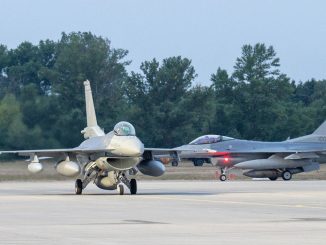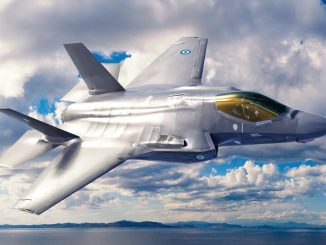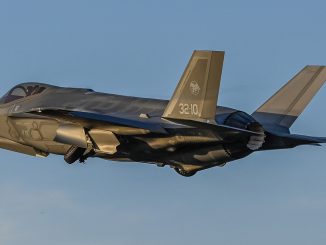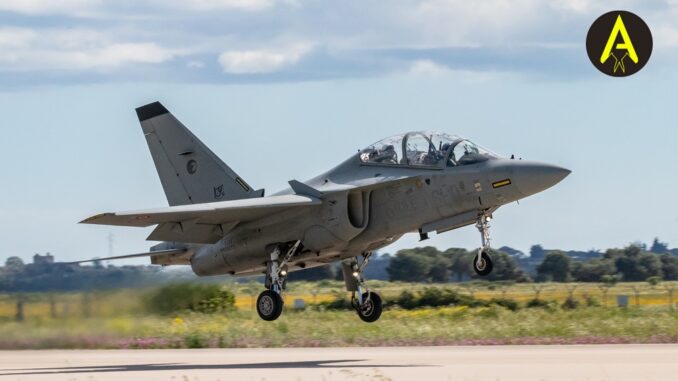
First part of our in-depth report on the 61° Stormo.
Lecce-Galatina Air Base, in southeastern Italy, is the home of the basic training of all Italian military pilots and the advanced training of the future fighter pilots. The flight school of the 61° Stormo (Wing) based there, can boast a 77-year long tradition of training young aviators and make them fully fledged military pilots.
During these 77 years, the school has always looked at the future, undergoing many changes to always be up to date with the technological evolution. We recently had a chance to visit the 61st Wing to see today’s flight school and talk about the transformation that is taking place with the relocation of the T-346 and the arrival of the new T-345.
Some brief history facts
While the air base was established in 1931, only in 1945 it was decided to transform it in a flight school. A year later, on September 1st, 1946, the Scuola di Volo delle Puglie (literally “Flight School of Apulia”, from the region where the air base is located) was born. The school was primarily devoted to initial flight training, while advanced and pre-operational training were provided in other locations. Among the aircraft assigned to the school were the T-6 Texan, the Fiat G-59 and the P-51 Mustang.
In 1962 the school received the AerMacchi MB-326, becoming Scuola Volo Basico Iniziale Aviogetti (Initial Basic Jet Flight School). The new trainer was part of the “jet ab-initio” formula, which allowed pilots to be trained since the beginning on jet aircraft. Given the excellent results and the efficiency of this new type of training, this solution is still applied until today.
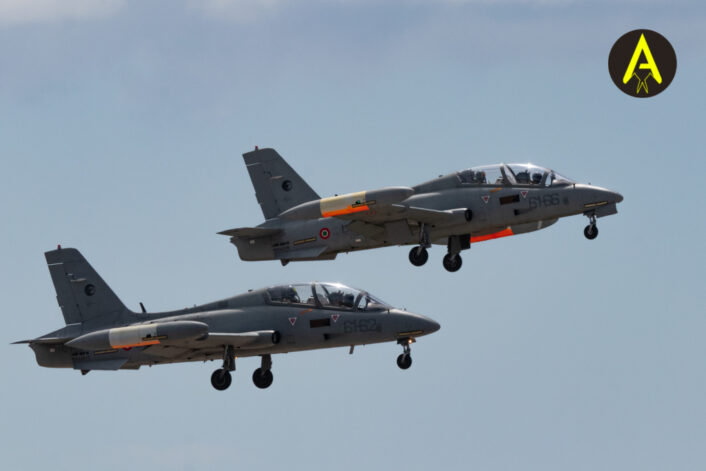
After 20 years and over 400,000 hours of flight, the MB-326 was replaced by the MB-339, which is still in service today (although in an upgraded form). The delivery of the new aircraft was followed shortly by another change of name, with the new one being 61^ Brigata Aerea (Air Brigade), before getting the final designation 61° Stormo in 1995. Since 2015, with the introduction of the T-346 and the adoption of a new training system, the Wing has focused in the training of future fighter pilots that will be assigned to 4th and 5th generation fighter aircraft.
Now, after 40 years of honorable service, the MB-339 is preparing for a much-deserved retirement. In fact, in 2020, the first two T-345 jet trainers were delivered to the Italian Air Force: the type is about to complete the developmental and operational training, with the final introduction in service planned this year.
The training of the Italian Air Force pilots
For some years now the Italian Air Force has been using a new training model divided into four phases. The students’ first introduction to flight happens while they are at the Air Force Academy, during Phase I at the 70° Stormo at Latina Air Base, near Rome, where they fly on the SF-260 piston-prop trainer and get their pilot license.
The Phase II, which is common for all future military pilots after the Academy, is flown in Galatina, where the students join the 61° Stormo and fly the MB-339A for the Primary Pilot Training. In alternative to Galatina, students might be sent to international schools abroad, such as the Euro-NATO Joint Jet Pilot Training at Sheppard AFB, Texas, the Undergraduate Pilot Training at Vance AFB, Oklahoma, and Columbus AFB, Mississippi, or Kalamata Air Base in Greece, where they fly the T-6 Texan II turboprop trainer.
The training abroad is completely equivalent to the Phase II training in Italy, with the only difference being the aircraft employed, which requires few months of jet familiarization before the pilots move to Phase III when they return in Italy. During this phase, pilots are continuously evaluated for the choice of their future assignment aircraft.
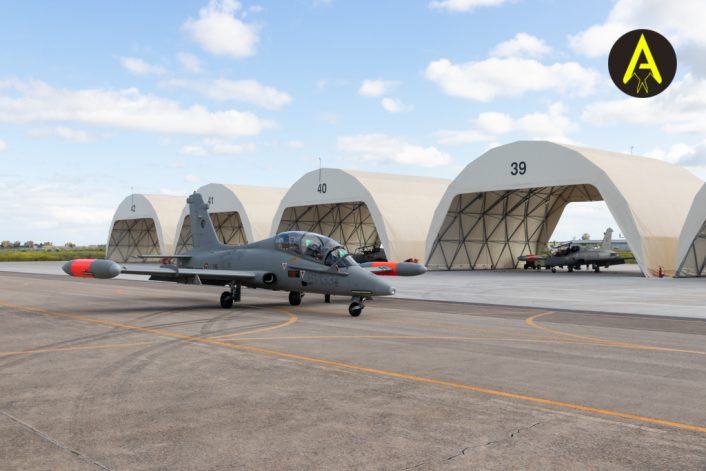
Phase III is now different based on what type of aircraft will be assigned to the pilots. In fact, pilots that will fly support aircraft, such as the C-130 or the KC-767, continue their training at Pratica di Mare Air Base’s CAE Multicrew, while pilots assigned to helicopters move to the 72° Stormo at Frosinone airfield. Pilots assigned to tactical jets and Remotely Piloted Aircraft stay in Galatina, where they continue with the Specialized Pilot Training on the MB-339CD. Pilots who complete Phase III, upon graduation, obtain the Military Pilot License.
Pilots assigned to fighter aircraft continue their training in Galatina with the Phase IV or Lead In to Fighter training, flying the T-346.
The T-346 prompted a revolution in the training, as it not only brought an aircraft, but an entire integrated system associated with simulators and multiple training aids. The performance of the aircraft, which are very similar to 4th and 5th gen aircraft, make the transition from the trainer to the Operational Conversion Unit extremely smooth, allowing also to offload training activities from the OCU to the Phase IV.
Summarizing, students that have never flown jets arrive at the 61st Wing and, after 2 years of training, they are ready to move on to high performance fighter jets in operational scenarios. In order to complete the training syllabus for the fighter role and be assigned to the Tornado, Eurofighter or F-35, the student needs a total of 30 months of training, which include about 255 flight missions, for a total of 318 flight hours, and 166 simulator sessions, for a total of about 178 hours. It’s a complex, demanding but absolutely efficient training and it represents a success model internationally.
International school
A little-known fact is that the flight school at Lecce-Galatina Air Base has been international since its beginning. In fact, the school already had foreign students in 1950, just our years after its creation. Since then, more than 400 foreign pilots graduated at the Italian flight school. This international tradition got a new significant impulse with the introduction of the T-346, which prompted a revolution of the Phase IV training and attracted a lot of international attention.
The Italian Air Force also created a continuous cultural exchange with the ENJJPT at Sheppard AFB and the other flight schools abroad, making sure that the training system is continuously updated while being conscious of how partner nations work for the maximum interoperability. This is especially important in order to make sure that pilots, whatever school they graduate from, have all the same capabilities and knowledge.
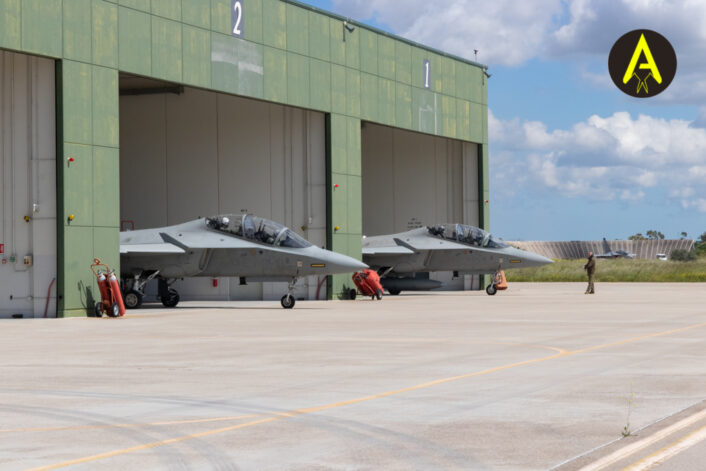
There are currently a total of nine countries (including Italy) with instructors and/or students at Galatina Air Base: Argentina, Austria, Germany, Greece, Kuwait, Singapore, Saudi Arabia and the United States, with Canada soon becoming the tenth nation to join the training program. Many other nations are also interested in the school and often visit the base to get a better knowledge of the training system.
All the international training agreements have different features, with some countries sending students to Galatina for the entire training program and others only for the LIFT training, some countries sending only instructors and some others sending both students and instructors. A point of strength of the school is the capability to adapt and tailor the training based on the specific needs of the partner air forces, thanks to a modular syllabus.
The 61° Stormo
A subordinate unit of the ItAF’s Training Command, the 61st Wing, since 2015, is articulated on three squadrons:
- 212° Gruppo (Squadron), flying the T-346A, specialized in the Phase IV training propaedeutic to the assignment to tactical jets. The unit is also in charge of the instructors’ training.
- 213° Gruppo, flying the MB-339CD (FT-339C), responsible of the Phase 3 training, which leads to the graduation of military pilots to be assigned the fighter and RPA roles.
- 214° Gruppo, flying the MB-339A (T-339A), in charge of the national Phase 2 training.
The 61° Stormo also includes the Centro Addestramento Equipaggi (Aircrew Training Center), the 961st Gruppo Efficienza Aeromobili (Aircraft Efficiency Unit), logistics unit, force protection, and all the different specializations needed by a Wing to operate normally.
Particularly important is the activity of the GEA, which is in charge of the maintenance needed to provide the squadrons with the required flight hours. This is done via the management of the efficiency of the aircraft fleet of the 61st Wing, the 1st and 2nd level ordinary maintenance, the training of the personnel, the quality control of the procedures and equipment, the maintenance and management of the emergency and survival equipment. Thanks to the efforts of the maintenance personnel, more than 40 missions are flown every day, with more than 10,000 annual flight hours.
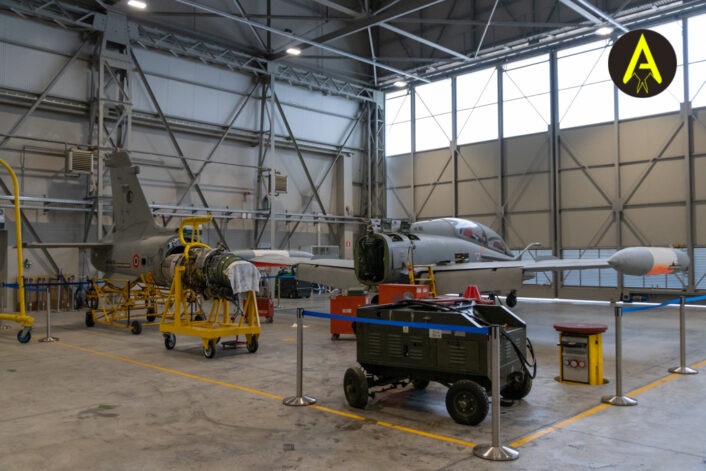
For instance, the activities of the GEA for the management of the MB-339 fleet include the HPFI (Hourly Post Flight Inspections) every 150 flight hours on both aircraft and engine, the periodic inspections every 250 flight hours until the 2,000 hours deadline after which the aircraft is sent to Leonardo for the IRAN (Inspection and Repair As Necessary). The GEA is also in charge of the HPFI every 100 hours for the T-346, as well as all the other corrective and programmed maintenance activities. This allows to grant the largest possible number of efficient aircraft that can be assigned to training missions every day.
Another unit which is based in Galatina is the 10° Reparto Manutenzione Velivoli (Aircraft Maintenance Centre), which is complementary to the GEA for the higher-level maintenance operations. The RMV, like the GEA, is in charge of a fleet of more than 40 MB-339 aircraft, including the ones operated by the Frecce Tricolori, as well as the T-345 and the T-346. In the specific, the RMV operates the 3rd and 4th level maintenance, which are among the most complex as they require the complete disassembly of the aircraft.
The aircraft
The 61st Wing uses highly advanced flight training systems compared to other schools. These technologies, by the integrated use of aircraft and simulators, allow to reduce the flight hours required to reach training goals and lower the costs, while exponentially improving the quality of the training which is now tailored to pilots that will fly on 4th and 5th gen aircraft.
As we often reported, the introduction into service of the T-346 revolutionized the training. The M-346 is not just an aircraft, but an integrated system associated with simulators and multiple training aids. It’s the ideal system to train future fighter pilots which are not only required to be good pilots, but they also need to manage the entire weapon system with all its sensors and weapons in scenarios which are getting more complex, less permissive and with plenty of threats. We will go further in the details about the use of the T-346 by the 61st Wing in the second part of this report which will be soon online.
An aircraft that has been for a long time a synonym of the 61° Stormo is the MB-339. In the last 40 years, the MB-339 “Macchino” graduated 2,500 pilots and flew for 400,000 hours. Even if it’s closing to the end of its service life, the MB-339 continues to demonstrate itself as an exceptional, safe, reliable machine, and is still used in the “analog” A variant for the Phase 2 and in the “digital” CD variant for the Phase 3.
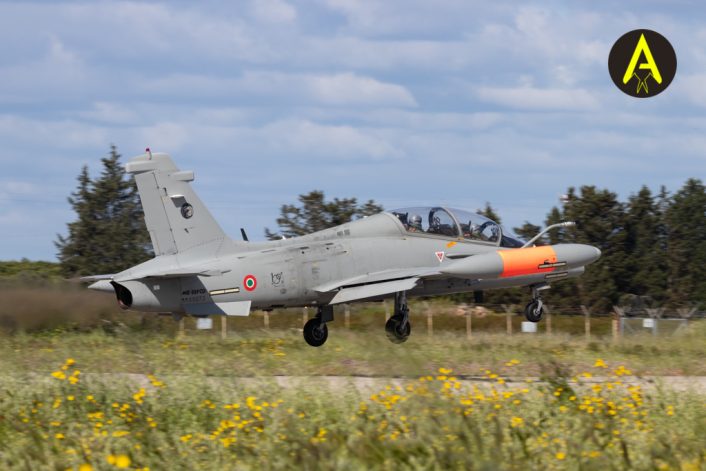
The MB-339 was born as a replacement for the MB-326 and designed with almost all Italian technology, with the exception of the Rolls-Royce Turbo Viper 632 engine. The MB-339 flew for the first time in 1976 and was introduced in service in 1981, immediately demonstrating great capabilities both as advanced trainer and as ground attack aircraft. Compared to the MB-326, the MB-339 has more power, better maneuverability and control’s precision. The forward part is also completely redesigned to have different heights for the pilot and instructor, allowing a better visibility from the rear seat.
The MB-339 became even more popular thanks to its adoption by the Frecce Tricolori National Aerobatic Team in 1982. The aircraft also had good commercial success outside of Italy, and has been in service in Argentina, Peru, Malaysia, New Zealand, Nigeria, United Arab Emirates, Eritrea and Ghana. Some MB-339s from New Zealand now found a second life with Draken International, which uses them to support training of allied air forces.
The MB-339 is now about to be replaced by the new T-345 High Efficiency Trainer. The T-345 is the new basic jet trainer of the Italian Air Force and will gradually replace the entire MB-339 fleet, beginning from the A variant and later continuing with the CD variant. In fact, thanks to its characteristics, the aircraft can be used for the entire training syllabus, from the Primary Pilot Training to the Specialized Pilot Trainig.
The T-345 will bring multiple advantages. Similarly to the M346, the new aircraft will be part of an integrated netcentric system, which will allow to shrink the time needed for the training while improving its quality and efficiency. The T-345 trainer offers performance typical of a jet aircraft, such as the maximum altitude and speed, with operational costs comparable to the ones of a turboprop aircraft.
The T-345 is equipped with simple and essential onboard systems, which require minimum maintenance and allow the maximum safety and reliability. The Williams FJ44-4M-34 turbofan engine is equipped with a modern digital control system and provides a good thrust with low fuel consumption. The acquisition costs are comparable to the ones of turboprop trainers, allowing a long service life of 15,000 flight hours.
The swept high wing provides a greater maneuverability and an easier recovery from dangerous attitudes, while its profile also creates a higher lift. The aircraft is equipped with the latest technologies, such as touchscreen multi-functional displays, exposing the students to these technologies, similar to the ones of front-line aircraft, early in the training, so they can gradually improve their competencies with such advanced avionics before reaching the OCUs.
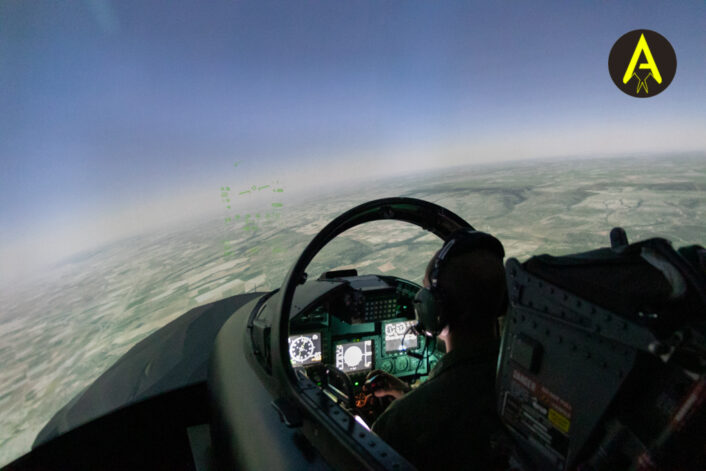
The future
The introduction of the T-345, which will gradually replace the MB-339 in the Phase II and III, will consolidate even more the new training model of the Italian Air Force and will allow a more fluid transition from basic training to advanced training. In fact, as we mentioned, the T-345 can be seen as an integrated training system similar to the one of the T-346, as they are both based on the same logic but with the latest technological advances for both avionics and ground training aids.
Allowing students to immediately get in touch with the most modern technologies and avoiding the transition to another aircraft, even if highly similar, for the Phase III training, will improve the efficiency and reduce even more the period required for the training. The T-345, having completed developmental and operational test and evaluation, will resume deliveries to the 61st Wing later this year.
In the meanwhile, the T-346 fleet is now relocating to the new facilities built at Decimomannu Air Base, where the 212° Gruppo will continue to operate together with the joint ItAF-Leonardo International Flight Training School. The facilities freed up by the T-346 at Lecce-Galatina Air Base will be repurposed for the T-345, adding to the new ones specifically built for the new aircraft.
The second part of this report will focus on the T-346, LIFT and IFTS. Stay tuned!

